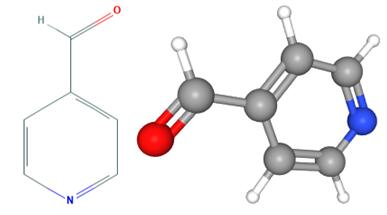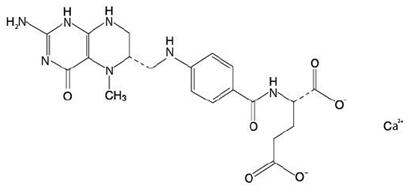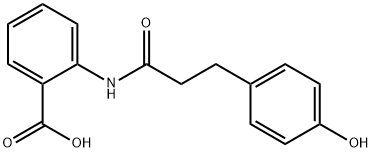2-(3-(4-hydroxyphenyl)propanamido)benzoic acid—a therapeutic treatment for allergic reaction
Dec 23,2019
2-(3-(4-hydroxyphenyl)propanamido)benzoic acid, also called hydroxyphenyl propamidobenzoic acid, is a good anti-irritant ingredient effectively reduces skin itching [1]. It is derived from the active ingredient of oat (Avena Sativa), also known as dihydro oat acyl anthranilic acid, oat avenanthramides or oat amide. Oat amide is an antioxidant substance unique in oat and has the highest content in the aleurone layer. Oat amide is used in bath product additives to relieve dry skin symptoms and skin itching.

Application
Allergy is the overreaction of the immune system to certain foreign substances that brought into contact with the body. Allergic reactions can occur at any age. The most important factor affecting allergic reactions is heredity. Another major influencing factor is the environment. Inferior skin care products can also cause skin allergic reaction. 2-(3-(4-hydroxyphenyl) propanamido) benzoic acid is a kind of efficient ingredients in anti-irritant and inflammation reduction. It is an antihistamine which can effectively reduces itching and redness. Moreover, this drug has a wide range of applications, such as a remarkable effect on skin care, hair care, body care and scalp care.
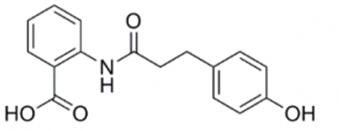
Advantages of NanoCalmin
Hydroxyphenyl propamidobenzoic acid has good efficacy but poor water solubility. NanoCalmin is nano-coated so as to give hydroxyphenyl propamidobenzoic acid better stability, efficacy and safety, and at the same time is easy to use in formula. NanoCalmin contains 5% hydroxyphenyl propamidobenzoic acid. NanoCalmin utilizes a nano-delivery system (NDS) that not only solves the solubility problems and stability problems of biopolyphenols and dihydro oat Avenanthramides, but also greatly increases absorption efficiency and bioavailability. NanoCalmin is lighter in color than the commercially available solution containing 5% hydroxyphenyl propamidobenzoic acid. NanoCalmin is very soluble in water and does not affect the pH of the system.
Safety
Some experts have studied the functional role of hydroxyphenyl propamidobenzoic acid in animals. The mice were fed in 2 groups. One is normal and the other added hydroxyphenyl propamidobenzoic acid at a dose of 0.1 g/kg, the purpose of which is to see the ability of this substance to regulate the tissue oxidation and antioxidant balance in the mice. In addition, 50 days after feeding the mice, the two groups of mice were divided into the exercise group and the non-exercise group to study the effect of hydroxyphenyl propamidobenzoic acid on the oxidation induced by exercise in the internal organs of mice.
The results showed that supplementation of hydroxyphenyl propamidobenzoic acid had no effect on the production of reactive oxygen species in most tissues except for the reduction of reactive oxygen species in the soleus muscle of mice, indicating that hydroxyphenyl propamidobenzoic acid does not affect cellular energy metabolism. Supplementation with hydroxyphenyl propamidobenzoic acid improves superoxide dismutase activity in the thigh muscles, liver, and kidney, and increases glutathione peroxidase activity in the thigh muscles and heart. Exercise can increase reactive oxygen species in muscle and myocardium to accelerate the peroxidation of heart, liver and muscle. It has been found through experiments that oat amide can slow down the production of reactive oxygen species caused by muscle movement and reduce the phenomenon of fat peroxidation in the heart. This indicates that oat amide should be added as an effective antioxidant to the diet.
Reference
[1] https://www.chemicalbook.com/ProductChemicalPropertiesCB73070520_EN.htm
[2] https://www.puriactives.com/en/?p=350
- Related articles
- Related Qustion
- 2-(3-(4-hydroxyphenyl)propanamido)benzoic acid: Preparation Method, Natural Sources and Potential in Skin Therapy Mar 13, 2024
Efficiently synthesized, 2-(3-(4-hydroxyphenyl)propanamido)benzoic acid from oats offers diverse biological benefits and shows promise in skincare, inhibiting UV-induced skin damage and aging.
- 2-(3-(4-hydroxyphenyl)propanamido)benzoic acid: activities and applications Aug 15, 2023
2-(3-(4-hydroxyphenyl)propanamido)benzoic acid: oats-derived compound with anti-inflammatory, cancer-inhibitory, and skin healing properties for therapy.
4-Pyridinecarboxaldehyde is a colorless oily liquid with a distinctive odor. Older samples are often brown-colored owing to impurities.....
Dec 20,2019Organic ChemistryLevomefolate calcium is a synthetic calcium salt of L-5-methyltetrahydrofolate (L-5-methyl-THF), which is a metabolite of vitamin B9.....
Dec 23,2019Supplements2-(3-(4-hydroxyphenyl)propanamido)benzoic acid
697235-49-7You may like
2-(3-(4-hydroxyphenyl)propanamido)benzoic acid manufacturers
- 2-(3-(4-hydroxyphenyl)propanamido)benzoic acid
-

- $0.00 / 1KG
- 2025-12-13
- CAS:697235-49-7
- Min. Order: 1KG
- Purity: 98.0%
- Supply Ability: 500kg/month
- 2-(3-(4-hydroxyphenyl)propanamido)benzoic acid
-

- $0.00 / 1kg
- 2025-12-12
- CAS:697235-49-7
- Min. Order: 0.001kg
- Purity: 99.99%
- Supply Ability: 2000000t
- Hydroxyphenyl Propamidobenzoic Acid
-
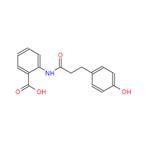
- $1.00 / 1KG
- 2025-12-12
- CAS:697235-49-7
- Min. Order: 1KG
- Purity: 99%
- Supply Ability: 200000KG




